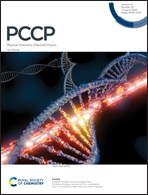Calculations of quantum tunnelling rates for muonium reactions with methane, ethane and propane
Abstract
Thermal rate constants for Mu + CH4, Mu + C2H6 and Mu + C3H8 and their equivalent reactions with H were evaluated with ab initio instanton rate theory. The potential-energy surfaces are fitted using Gaussian process regression to high-level electronic-structure calculations evaluated around the tunnelling pathway. This method was able to successfully reproduce various experimental measurements for the rate constant of these reactions. However, it was not able to reproduce the faster-than-expected rate of Mu + C3H8 at 300 K reported by Fleming et al. [Phys. Chem. Chem. Phys., 2015, 17, 19901 and Phys. Chem. Chem. Phys., 2020, 22, 6326]. Analysis of our results indicates that the kinetic isotope effect at this temperature is not significantly influenced by quantum tunnelling. We consider many possible factors for the discrepancy between theory and experiment but conclude that in each case, the instanton approximation is unlikely to be the cause of the error. This is in part based on the good agreement we find between the instanton predictions and new multiconfigurational time-dependent Hartree (MCTDH) calculations for Mu + CH4 using the same potential-energy surface. Further experiments will therefore be needed to resolve this issue.



 Please wait while we load your content...
Please wait while we load your content...